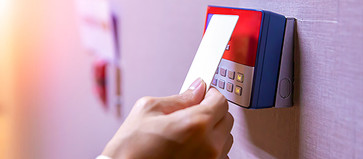Should You Use Employee ID Badges for Time Clocking?
If you’re already using employee ID badges in your company, you know that they can help with everything from improving security to furthering your company branding. But if you aren’t also using ID cards for employee time tracking, you could be missing out on an opportunity to make the most of what they can do for your company.
While ID card time clocks may not be needed in every environment, they can be particularly helpful if your organization depends on hourly workers. It can help ensure more honesty in the system, as it eliminates a fairly common practice known as “ buddy punching.” This happens when an employee asks a co-worker to clock in or clock out for them when they aren’t actually there. This could be because they’re running late or want to leave work early; either way, the American Payroll Association reports that about 75% of U.S. companies are victims of buddy punching, and it adds up to tens, if not hundreds of thousands of dollars per company.
When you need to know how to track employee time and attendance, an ID card time clock could be both a time- and money-saver for your company.
Types of ID Badge Cards
Before you decide whether an ID card timekeeping system is right for you, it’s important to know a little bit about ID badges. ID badge cards come in two basic formats:
- Proximity cards, also called prox cards, which are contactless cards that don’t need to be inserted into a card reader. Instead, they use RFID technology to send the data to a card reader, which eliminates the need for any type of contact between the card and reader.
- Magnetic stripe cards, which can also be called a swipe card or magstripe. They must be swiped on a magnetic reading head for their information to be shared.
Prox cards have many advantages over magstripes since they are scanned more quickly. With RFID technology, all that is required is for the card to get close enough for the reader to pick up the signal via wireless communication. Because a magnetic stripe card must be read or the bar code must be scanned, it requires the individual with the card to stop, insert it, and wait for it to be read. Those seconds quickly add up to minutes and, over time, translate into lost hours, days and even weeks.
Another downside to using magstripes is that, over time, they become weaker and can suddenly become demagnetized. That can create headaches for HR or for managers and will require more frequent card replacement. The readers can also wear out more quickly due to the repeated friction of cards being swiped. So, unless magstripes are already in use in your company, a prox card is going to be the more cost-effective and time-efficient solution.
If your company is already using badges for IDs or as access cards, it is easy to implement them as a timekeeping component. Employees are already accustomed to wearing them or carrying them, so you’ll eliminate some of the common challenges of implementing a badge program — such as employees accidentally (or even intentionally) leaving them at home. And it’s also easy to add one more feature to the card to make it work as a time tracking device.
Pros and Cons of Keeping Time with Badge Cards
Badge cards that double as timecards solve a couple of problems. For one, they eliminate (or significantly reduce) the practice of buddy punching, since the employee needs to have the card on him or her both to clock in and to gain access to the building. Of course, there are always going to be exceptions to this rule, but overall, it makes it extremely difficult and inconvenient for buddy punching to continue.
When combined with a time clock system, a prox card ID badge can dramatically speed things up. If several employees arrive for a shift at the same time, there can be bottlenecks as workers wait in line to punch in. When using a prox card ID badge as a timekeeping device, workers can get in — and get clocked in — faster and more efficiently. They don’t need to remove gloves to punch in numbers on a keypad, and the contactless smart card reader is also becoming a popular choice in light of COVID-19 concerns.
Other Considerations Before You Switch
Of course, there are a few other things to consider as you look at implementing an ID card time clock system, such as how to manage badges that are lost, forgotten or destroyed. When an employee needs to also use the badge to clock in, but forgets or loses the badge, there needs to be a plan in place. Will they be issued a temporary card that must be returned at the end of the day? Will they be clocked in by their manager and expected to have their original card the next day?
It’s always helpful to look at all the possible situations that could arise with a new time clock system in place and create a proactive plan. It can also be useful to create an ID badge policy that all employees must sign off on. The policy can include penalties for repeatedly “misplacing” or forgetting a badge as well as introducing fees for a replacement card — which can be helpful in ensuring that employees take ownership of their card more seriously.
Time for Change?
If you decide that adding an ID badge time clock system is right for your organization, ID Shop can help you create badges that will fit your needs. We also are here to answer whatever questions you have on which products might be best for you.



